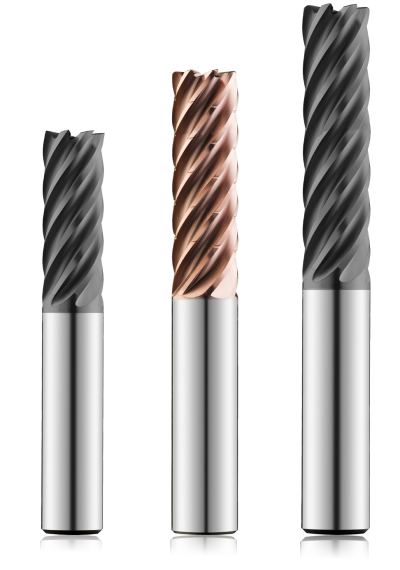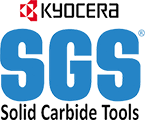
KYOCERA SGS Precision Tools announces a new expansion to the H-Carb seven-flute high efficiency end mill series with an array of larger corner radii options to better serve customer demands.
The H-Carb Series 77 end mills specialize in deep axial trochoidal and high-speed machining applications and are offered in various lengths of cut. The specially designed core and flute design improve rigidity and chip flow while reducing deflection. The seven-flute design allows for superior finishes at higher speed and feed rates versus 5 and 6 flute tools.
The impressive H-Carb portfolio now includes 72 new tools featuring 2,0mm, 3,0mm, and 4,0mm corner radius sizes and are available in 3 lengths of cut (2.5xD, 3xD and 4xD). Coatings are available in Ti-NAMITE®- A and Ti-NAMITE®-M making them suitable for dry machining in ferrous based materials such as cast irons and numerous carbon steels. The Chip Breaker profile is standard with a wide range of square end and corner radii options offered to meet a variety of machining specifications.
Benefits:
-
Heavy duty core and specialized flute design for improved rigidity, chip flow and reduced deflection.
-
Chip Breaker profile standard in portfolio and aids in chip flow, especially in deep pocketing operations.
-
Deep pocketing and slotting capability using the various lengths of cut offered applying a trochoidal tool path.
-
CAM programming methods using high efficiency machining by applying trochoidal tool paths and incorporating constant cutter engagement.
-
Available in 3 lengths of cut (2.5xD, 3xD, 4xD).
-
Available in Ti-NAMITE®-A and Ti-NAMITE®-M suitable for dry machining
in ferrous based materials such as cast irons and many carbon steels.
Features:
-
Cutting Diameter: 1/4" - 1" / 6,0-25,0
-
Length of Cut: 5/8" - 4" / 15,0-100,0
-
Overall Length: 2 1/2"-7" / 63,0-170,0
-
Shank Diameter: 1/4"-1" / 6,0-25,0
-
Corner Radius: .015-.120 / 0,3-4,0
-
Coating(s): Ti-NAMITE®-M, Ti-NAMITE®-A
-
Special Options: Chip Breaker
Material Applications:
- Steel ≤ 45 HRc
- Stainless Steel ≤ 45HRc
- Cast Iron ≤ 45HRc
- High-Temp Alloys
- Titanium Alloys ≤ 45 HRc
Industry Applications:
-
Aerospace
-
Medical
-
Power Generation
-
Automotive
-
Mold & Die
-
Casting & Foundries
-
General Engineering
Contact Details
Related Glossary Terms
- alloys
alloys
Substances having metallic properties and being composed of two or more chemical elements of which at least one is a metal.
- carbon steels
carbon steels
Known as unalloyed steels and plain carbon steels. Contains, in addition to iron and carbon, manganese, phosphorus and sulfur. Characterized as low carbon, medium carbon, high carbon and free machining.
- cast irons
cast irons
Cast ferrous alloys containing carbon in excess of solubility in austenite that exists in the alloy at the eutectic temperature. Cast irons include gray cast iron, white cast iron, malleable cast iron and ductile, or nodular, cast iron. The word “cast” is often left out.
- computer-aided manufacturing ( CAM)
computer-aided manufacturing ( CAM)
Use of computers to control machining and manufacturing processes.
- die casting
die casting
Casting process wherein molten metal is forced under high pressure into the cavity of a metal mold.
- feed
feed
Rate of change of position of the tool as a whole, relative to the workpiece while cutting.
- milling machine ( mill)
milling machine ( mill)
Runs endmills and arbor-mounted milling cutters. Features include a head with a spindle that drives the cutters; a column, knee and table that provide motion in the three Cartesian axes; and a base that supports the components and houses the cutting-fluid pump and reservoir. The work is mounted on the table and fed into the rotating cutter or endmill to accomplish the milling steps; vertical milling machines also feed endmills into the work by means of a spindle-mounted quill. Models range from small manual machines to big bed-type and duplex mills. All take one of three basic forms: vertical, horizontal or convertible horizontal/vertical. Vertical machines may be knee-type (the table is mounted on a knee that can be elevated) or bed-type (the table is securely supported and only moves horizontally). In general, horizontal machines are bigger and more powerful, while vertical machines are lighter but more versatile and easier to set up and operate.
- shank
shank
Main body of a tool; the portion of a drill or similar end-held tool that fits into a collet, chuck or similar mounting device.
- slotting
slotting
Machining, normally milling, that creates slots, grooves and similar recesses in workpieces, including T-slots and dovetails.

